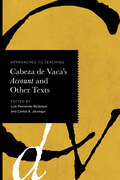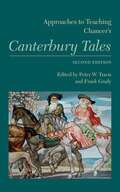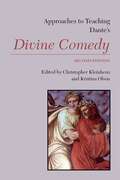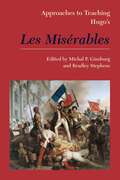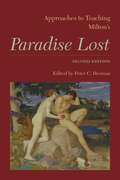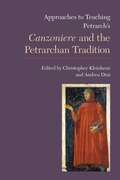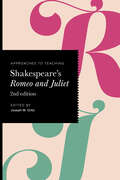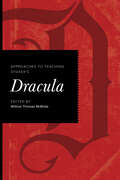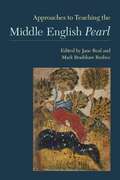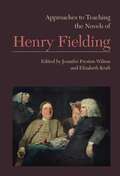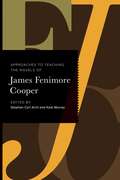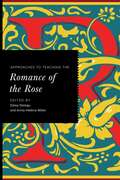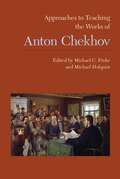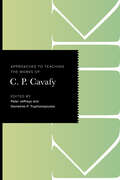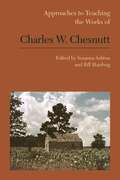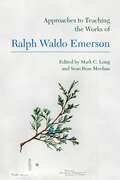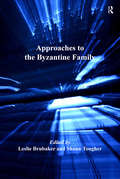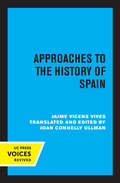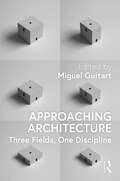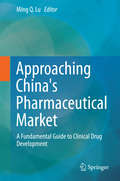- Table View
- List View
Approaches to Teaching Cabeza de Vaca's Account and Other Texts (Approaches to Teaching World Literature #181)
by Luis Fernando Restrepo Carlos A. JáureguiIn 1527 Ã�lvar Núñez Cabeza de Vaca journeyed from Spain to Florida with the ill-fated Pánfilo de Narváez expeditionâ€"and ended up wandering by land for years with a small band of survivors before reaching Spanish outposts in modern-day Mexico. He later traveled to South America as an appointed provincial governor, only to be sent back to Spain in chains some years after his arrival. His written works describing his experiences provide insights into the lives of the indigenous peoples of the Americas and the attitudes of the Spanish conquistadores.This volume provides background about the texts and discusses new ways to teach them, challenging outdated readings that erase the violence of Spanish imperialism. Essays examine the role of the enslaved African Esteban in Cabeza de Vaca's account of the North American expedition, the indigenous and Spanish women who appear in the explorer's texts, Cabeza de Vaca's performance of multiple gender roles, and the reception of these works as examples of Chicano or Latin American literature. The volume also explores connections to archaeological findings and food studies.
Approaches to Teaching Chaucer's Canterbury Tales (Approaches to Teaching World Literature #131)
by Frank Grady Peter W. TravisChaucer's Canterbury Tales was the subject of the first volume in the Approaches to Teaching series, published in 1980. But in the past thirty years, Chaucer scholarship has evolved dramatically, teaching styles have changed, and new technologies have created extraordinary opportunities for studying Chaucer. This second edition of Approaches to Teaching Chaucer's Canterbury Tales reflects the wide variety of contexts in which students encounter the poem and the diversity of perspectives and methods instructors bring to it. Perennial topics such as class, medieval marriage, genre, and tale order rub shoulders with considerations of violence, postcoloniality, masculinities, race, and food in the tales.The first section, "Materials," reviews available editions, scholarship, and audiovisual and electronic resources for studying The Canterbury Tales. In the second section, "Approaches," thirty-six essays discuss strategies for teaching Chaucer's language, for introducing theory in the classroom, for focusing on individual tales, and for using digital resources in the classroom. The multiplicity of approaches reflects the richness of Chaucer's work and the continuing excitement of each new generation's encounter with it.
Approaches to Teaching Dante's Divine Comedy (Approaches to Teaching World Literature #163)
by Christopher Kleinhenz and Kristina OlsonDante's Divine Comedy can compel and shock readers: it combines intense emotion and psychological insight with medieval theology and philosophy. This volume will help instructors lead their students through the many dimensions--historical, literary, religious, and ethical--that make the work so rewarding and enduringly relevant yet so difficult.Part 1, "Materials," gives instructors an overview of the important scholarship on the Divine Comedy. The essays of part 2, "Approaches," describe ways to teach the work in the light of its contemporary culture and ours. Various teaching situations (a first-year seminar, a creative writing class, high school, a prison) are considered, and the many available translations are discussed.
Approaches to Teaching Hugo's Les Misérables (Approaches to Teaching World Literature #150)
by Bradley Stephens Michal P. GinsbugThe greatest work of one of France's greatest writers, Victor Hugo's Les Misérables has captivated readers for a century and a half with its memorable characters, its indictment of injustice, its concern for those suffering in misery, and its unapologetic embrace of revolutionary ideals. The novel's length, multiple narratives, and encyclopedic digressiveness make it a pleasure to read but a challenge to teach, and this volume is designed to address the needs of instructors in a variety of courses that include the novel in excerpts or as a whole.Part 1 of the volume, "Materials," provides guidance on editions in French and in English translation, biographies, criticism, and maps. Part 2, "Approaches," contains essays that discuss the novel's conceptions of misère, sexuality, and the politics of the time and that demonstrate techniques for teaching context including the book's literary market, its adaptations, its place in popular culture, and its relation to other novels of its time.
Approaches to Teaching Langland's Piers Plowman (Approaches to Teaching World Literature #151)
by Thomas A. GoodmannA series of dream visions, Piers Plowman is a moral reckoning of the whole of medieval England, in which every part of society--from church and king to every sort of "folk"--is considered in the light of the narrator's interpretation of Christian revelation. The Middle English poem, rich and beautiful, is a particular challenge to teach: it exists in three versions, lacks a continuous narrative, is written in a West Midlands dialect, weaves a complex allegory, and treats complicated social and political issues, such as labor, Lollardy, and popular uprising.Part 1 of this volume, "Materials," discusses the different versions, critical and classroom editions, and translations of the poem, as well as the many secondary sources. Part 2, "Approaches," helps students engage with the poem's versification, understand its protagonist and its treatment of poverty and equity, and discern connections to the work of other medieval poets, such as Dante and Chaucer.
Approaches to Teaching Milton's Paradise Lost: second edition (Approaches to Teaching World Literature #122)
by Peter C. Herman Elizabeth Sauer Anthony Welch Achsah Guibbory Jessica Wolfe Regina Schwartz Abraham Stoll Gregory M. Semenza Randall IngramThis second edition of Approaches to Teaching Milton's Paradise Lost addresses Milton in the light of the digital age, new critical approaches to his poem, and his continued presence in contemporary culture. It aims to help instructors enliven the teaching of Paradise Lost and address the challenges presented to students by the poem--the early modern syntax and vocabulary, the political and theological contexts, and the abounding classical references.The first part of the volume, "Materials," evaluates the many available editions of the poem, points to relevant reference works, recommends additional reading, and outlines useful audiovisual and online aids for teaching Milton's epic poem. The essays in the second part, "Approaches," are grouped by several themes: literary and historical contexts, characters, poetics, critical approaches, classrooms, and performance. The essays cover epic conventions and literary and biblical allusions, new approaches such as ecocriticism and masculinity studies, and reading Milton on the Web, among other topics.
Approaches to Teaching Petrarch's Canzoniere and the Petrarchan Tradition (Approaches to Teaching World Literature #129)
by Christopher Kleinhenz Andrea DiniOne of the most important authors of the Middle Ages, Petrarch occupies a complex position: historically, he is a medieval author, but, philosophically, he heralds humanism and the Renaissance. Teachers of Petrarch's Canzoniere and his formative influence on the canon of Western European poetry face particular challenges. Petrarch's poetic style brings together the classical tradition, Christianity, an exalted sense of poetic vocation, and an obsessive love for Laura during her life and after her death in ways that can seem at once very strange and--because of his style's immense influence--very familiar to students. This volume aims to meet the varied needs of instructors, whether they teach Petrarch in Italian or in translation, in surveys or in specialized courses, by providing a wealth of pedagogical approaches to Petrarch and his legacy.Part 1, "Materials," reviews the extensive bibliography on Petrarch and Petrarchism, covering editions and translations of the Canzoniere, secondary works, and music and other audiovisual and electronic resources. Part 2, "Approaches," opens with essays on teaching the Canzoniere and continues with essays on teaching the Petrarchan tradition. Some contributors use the design and structure of the Canzoniere as entryways into the work; others approach it through discussion of Petrarch's literary influences and subject matter or through the context of medieval Christianity and culture. The essays on Petrarchism map the poet's influence on the Italian lyric tradition as well as on other national literatures, including Spanish, French, English, and Russian.
Approaches to Teaching Shakespeare's Romeo and Juliet (Approaches to Teaching World Literature #174)
by Joseph M. OrtizBy the time they encounter Romeo and Juliet in the classroom, many students have already been exposed to various, and sometimes incongruous, manifestations of Shakespeare's work. This volume makes a virtue of students' familiarity with the preconceptions, anachronisms, and appropriations that shape experiences of the work, finding innovative pedagogical possibilities in the play's adaptations and in new technologies that spark students' creative responses.The essays cover a wide area of concerns, such as marriage, gender, queer perspectives, and girlhood, and contributors embrace different ways of understanding the play, such as through dance, editing, and acting. The final essays focus on decolonizing the text by foregrounding both the role of race and economic inequality in the play and the remarkable confluence of Romeo and Juliet and Hispanic culture.
Approaches to Teaching Stoker's Dracula
by William Thomas McBrideThis volume helps teachers contextualize Bram Stoker's Dracula in its historical and cultural moment, considering psychology, technology, gender roles, colonialism, and anxieties about the other. It also situates the novel among the kindred texts that have proliferated since its publication, from film and television to the growing genre of vampire novels.Essays explore the novel in terms of medical humanities, contagion, and the gothic as well as ethnicity, identity, and race. Contributors analyze Dracula in the context of various ancient and modern cultural productions, including classical Indian aesthetics and African American vampire literature, and describe a broad range of classroom settings, including a technical university, a Hispanic-serving institution, and others.
Approaches to Teaching The Plum in the Golden Vase (Approaches to Teaching World Literature #159)
by Andrew SchonebaumThe Plum in the Golden Vase (also known as The Golden Lotus) was published in the early seventeenth century and may be the first long work of Chinese fiction written by a single (though anonymous) author. Featuring both complex structural elements and psychological and emotional realism, the novel centers on the rich merchant Ximen Qing and his household and describes the physical surroundings and material objects of a Ming Dynasty city. In part a social, political, and moral critique, the novel reflects on hierarchical power relations of family and state and the materialism of life at the time.The essays in this volume provide ideas for teaching the novel using a variety of approaches, from questions of genre, intertextuality, and the novel's reception to material culture, family and social dynamics, and power structures in sexual relations. Insights into the novel's representation of Buddhism, Chinese folk religion, legal culture, class, slavery, and obscenity are offered throughout the volume.
Approaches to Teaching the Middle English Pearl (Approaches to Teaching World Literature #143)
by Jane Beal and Mark Bradshaw BusbeeThe moving, richly allegorical poem Pearl was likely written by the anonymous poet who also penned Sir Gawain and the Green Knight. In it, a man in a garden, grieving the loss of a beloved pearl, dreams of the Pearl-Maiden, who appears across a stream. She teaches him the nature of innocence, God's grace, meekness, and purity. Though granted a vision of the New Jerusalem by the Pearl-Maiden, the dreamer is pained to discover that he cannot cross the stream himself and join her in bliss--at least not yet. This extraordinary poem is a door into late medieval poetics and Catholic piety.Part 1 of this volume, "Materials," introduces instructors to the many resources available for teaching the canonical yet challenging Pearl, including editions, translations, and scholarship on the poem as well as its historical context. The essays in part 2, "Approaches," offer instructors tools for introducing students to critical issues associated with the poem, such as its authorship, sources and analogues, structure and language, and relation to other works of its time. Contributors draw on interdisciplinary approaches to outline ways of teaching Pearl in a variety of classroom contexts.
Approaches to Teaching the Novels of Henry Fielding (Approaches to Teaching World Literature #139)
by Jennifer Preston Wilson and Elizabeth KraftThe works of Henry Fielding, though written nearly three hundred years ago, retain their sense of comedy and innovation in the face of tradition, and they easily engage the twenty-first-century student with many aspects of eighteenth-century life: travel, inns, masquerades, political and religious factions, the '45, prisons and the legal system, gender ideals and realities, social class.Part 1 of this volume, "Materials," discusses the available editions of Joseph Andrews, Tom Jones, Shamela, Jonathan Wild, and Amelia; suggests useful critical and contextual works for teaching them; and recommends helpful audiovisual and electronic resources. The essays of part 2, "Approaches," demonstrate that many of the methods and models used for one novel-- the romance tradition, Fielding's legal and journalistic writing, his techniques as a playwright, the ideas of Machiavelli-- can be adapted to others.
Approaches to Teaching the Novels of James Fenimore Cooper (Approaches to Teaching World Literature #172)
by Deepika Bahri Filippo MenozziA cosmopolitan author who spent nearly a decade in Europe and was versed in the works of his British and French contemporaries, James Fenimore Cooper was also deeply concerned with the America of his day and its history. His works embrace themes that have dominated American literature since: the frontier; the oppression of Native Americans by Europeans; questions of race, gender, and class; and rugged individualism, as represented by figures like the pirate, the spy, the hunter, and the settler. His most memorable character, Natty Bumppo, has entered into American popular culture.The essays in this volume offer students bridges to Cooper's novels, which grapple with complex moral issues that are still crucial today. Engaging with film adaptations, cross-culturalism, animal studies, media history, environmentalism, and Indigenous American poetics, the essays offer new ways to bring these novels to life in the classroom.
Approaches to Teaching the Romance of the Rose (Approaches to Teaching World Literature #170)
by Daisy Delogu and Anne-Hélène MillerOne of the most influential texts of its time, the Romance of the Rose offers readers a window into the world view of the late Middle Ages in Europe, including notions of moral philosophy and courtly love. Yet the Rose also explores topics that remain relevant to readers today, such as gender, desire, and the power of speech. Students, however, can find the work challenging because of its dual authorship by Guillaume de Lorris and Jean de Meun, its structure as an allegorical dream vision, and its encyclopedic length and scope. The essays in this volume offer strategies for teaching the poem with confidence and enjoyment. Part 1, "Materials," suggests helpful background resources. Part 2, "Approaches," presents contexts, critical approaches, and strategies for teaching the work and its classical and medieval sources, illustrations, and adaptations as well as the intellectual debates that surrounded it.
Approaches to Teaching the Works of Anton Chekhov (Approaches to Teaching World Literature #141)
by Michael C. Finke and Michael HolquistChekhov's works are unflinching in the face of human frailty. With their emphasis on the dignity and value of individuals during unique moments, they help us better understand how to exist with others when we are fundamentally alone. Written in Russia at the end of the nineteenth century, when the country began to move fitfully toward industrialization and grappled with the influence of Western liberalism even as it remained an autocracy, Chekhov's plays and stories continue to influence contemporary writers.The essays in this volume provide classroom strategies for teaching Chekhov's stories and plays, discuss how his medical training and practice related to his literary work, and compare Chekhov with writers both Russian and American. The volume also aims to help instructors with the daunting array of new editions in English, as well as with the ever-growing list of titles in visual media: filmed theater productions of his plays, adaptations of the plays and stories scripted for film, and amateur performances freely available online.
Approaches to Teaching the Works of C. P. Cavafy (Approaches to Teaching World Literature #175)
by Peter Jeffreys Demetres P. TryphonopoulosKnown as a preeminent poet of queer male desire, C. P. Cavafy lived most of his life as part of the Greek minority community in Alexandria, Egypt. He was inspired by the possibilities offered by peripheries, whether sexual, geographic, or historical. Volumes of his poems, widely translated into English, give anglophone readers access to his distinctive mixture of irony and tenderness, directness and subtlety.This volume will help instructors introduce students to Cavafy's works and explore them from many angles with the help of the extensive archives now available. Essays address teaching Cavafy both as a poetic historian of the Hellenistic, Roman, and Byzantine worlds and through the lens of postcoloniality. They also explore how he interpreted classical Greek works and how his work has been interpreted by composers, poets, and readers within and beyond Greece and the Greek diaspora.
Approaches to Teaching the Works of Charles W. Chesnutt (Approaches to Teaching World Literature #149)
by Susanna Ashton and Bill HardwigGrowing up in Cleveland after the Civil War and during the brutal rollback of Reconstruction and the onset of Jim Crow, Charles W. Chesnutt could have passed as white but chose to identify himself as black. An intellectual and activist involved with the NAACP who engaged in debate with Booker T. Washington and W. E. B. Du Bois, he wrote fiction and essays that addressed issues as various as segregation, class among both blacks and whites, Southern nostalgia, and the Wilmington coup d'état of 1898. The portrayals of race, racial violence, and stereotyping in Chesnutt's works challenge teachers and students to contend with literature as both a social and an ethical practice.In part 1 of this volume, "Materials," the editors survey the critical reception of Chesnutt's works in his lifetime and after, along with the biographical, critical, and archival texts available to teachers and students. The essays in part 2, "Approaches," address such topics in teaching Chesnutt as his use of dialect, the role of intertextuality and genre in his writing, irony, and his treatment of race, economics, and social justice.
Approaches to Teaching the Works of Christine de Pizan (Approaches to Teaching World Literature #148)
by Andrea TarnowskiA prolific poet and a protofeminist, Christine de Pizan worked within a sophisticated late medieval court culture and formed an identity as an authority on her society's preoccupations with religion, politics, and morality. Her works address various aspects of misogyny, the appropriate actions of rulers, and the ethical framework for social conduct. In addition to gaining a readership in fifteenth-century France, Christine's works influenced writers in Tudor England and were identified by twentieth-century readers as important contributions both to the emergence of a professional literary class and to the intellectual climate that gave rise to early modern Europe.Part 1 of this volume, "Materials," surveys the editions in Middle French, translations into modern French and English, and the many scholarly resources and critical reactions of the past fifty years. Part 2, "Approaches," provides insights into various aspects of Christine's works that can be explored with students, from considerations of genre and form to the themes of virtue, history, and memory. Teachers of French, English, world literature, and women's studies will find useful ideas throughout the volume.
Approaches to Teaching the Works of Inca Garcilaso de la Vega (Approaches to Teaching World Literature #169)
by Christian Fernández and José Antonio MazzottiThe author of Comentarios reales and La Florida del Inca, now recognized as key foundational works of Latin American literature and historiography, Inca Garcilaso de la Vega was born in 1539 in Cuzco, the son of a Spanish conquistador and an Incan princess, and later moved to Spain. Recalling the family stories and myths he had heard from his Quechua-speaking relatives during his youth and gathering information from friends who had remained in Peru, he created works that have come to indelibly shape our understanding of Incan history and administration. He also articulated a new American identity, which he called mestizo.This volume provides guidance on the translations of Garcilaso's writings and on the scholarly reception of his ideas. Instructors will discover ideas for teaching Garcilaso's works in relation to indigenous thought, European historiography, natural history, indigenous religion and Christianity, and Incan material culture. In essays informed by postcolonial and decolonial perspectives, scholars draw connections between Garcilaso's writings and contemporary issues like migration, multiculturalism, and indigenous rights.
Approaches to Teaching the Works of Ralph Waldo Emerson (Approaches to Teaching World Literature #155)
by Mark C. Long and Sean Ross MeehanA leader of the transcendentalist movement and one of the country's first public intellectuals, Ralph Waldo Emerson has been a long-standing presence in American literature courses. Today he is remembered for his essays, but in the nineteenth century he was also known as a poet and orator who engaged with issues such as religion, nature, education, and abolition.This volume presents strategies for placing Emerson in the context of his time, for illuminating his rhetorical techniques, and for tracing his influence into the present day and around the world. Part 1, "Materials," offers guidance for selecting classroom editions and information on Emerson's life, contexts, and reception. Part 2, "Approaches," provides suggestions for teaching Emerson's works in a variety of courses, not only literature but also creative writing, religion, digital humanities, media studies, and environmental studies. The essays in this section address Emerson's most frequently anthologized works, such as Nature and "Self-Reliance," along with other texts including sermons, lectures, journals, and poems.
Approaches to the Byzantine Family (Birmingham Byzantine and Ottoman Studies #14)
by Shaun Tougher Leslie BrubakerThe study of the family is one of the major lacunas in Byzantine Studies. Angeliki Laiou remarked in 1989 that ’the study of the Byzantine family is still in its infancy’, and this assertion remains true today. The present volume addresses this lacuna. It comprises 19 chapters written by international experts in the field which take a variety of approaches to the study of the Byzantine family, and embrace a chronological span from the later Roman to the late Byzantine empire. The context is established by chapters focusing on the Roman roots of the Byzantine family, the Christianisation of the family, and the nature of the family in contemporaneous cultures (the late antique west and the Islamic east). Key methodological approaches to the Byzantine family are highlighted and discussed, in particular prosopographical and life course approaches. The contribution of hagiography to the understanding of the Byzantine family is analysed by several authors; other chapters on the family and children in art and on the archaeology of the Middle Byzantine house explore the material evidence that can shed light on the Byzantine family. Overall, the diversity of families that existed in Byzantium (blood, fictive, metaphorical) is emphasised, and chapters consider the specific cases of ascetic, monastic, aristocratic and peasant families, as well as the imperial family, which is illuminated by the comparative case of a Caliphal family. The volume is topped and tailed by a Preface and an Afterword by the editors, which address the state of the field and consider the way ahead. Thus the volume is vital in putting the subject of the Byzantine Family in sharp focus and setting the research agenda for the future.
Approaches to the Evolution of Language: Language Evolution
by Rudolf BothaHow can we unravel the evolution of language, given that there is no direct evidence about it? Rudolf Botha addresses this intriguing question in his fascinating new book. Inferences can be drawn about language evolution from a range of other phenomena, serving as windows into this prehistoric process. These include shell-beads, fossil skulls and ancestral brains, modern pidgin and creole languages, homesign systems and emergent sign languages, modern motherese, language use of modern hunter-gatherers, first language acquisition, similarities between language and music, and comparative animal behaviour. The first systematic analysis of the Windows Approach, it will be of interest to students and researchers in many disciplines, including anthropology, archaeology, linguistics, palaeontology and primatology, as well as anyone interested in how language evolved.
Approaches to the History of Spain
by Jaime Vicens VivesThis title is part of UC Press's Voices Revived program, which commemorates University of California Press’s mission to seek out and cultivate the brightest minds and give them voice, reach, and impact. Drawing on a backlist dating to 1893, Voices Revived makes high-quality, peer-reviewed scholarship accessible once again using print-on-demand technology. This title was originally published in 1970.
Approaching Architecture: Three Fields, One Discipline
by Miguel GuitartThe study of the architectural discipline suffers from an increasing disconnect between its teaching and its professional practice. In this edited collection, 18 architectural voices address this disconnect by reflecting on the ways in which they exercise the architectural discipline in three ways: research, teaching, and practice. This book argues that the totality of activities encompassed by the architectural profession can be best fulfilled when reconsidering the critical interactions between these three fields in the everyday exercise of the profession. Split into three parts, "Architecture as Research," Architecture as Pedagogy," and "Architecture as Practice," each section focuses on one of these three dimensions while establishing continuity with the other two. In doing so, the book not only favors a more fulfilling interaction between academia and the profession but also reinforces the implementation of design theory and research in everyday teaching and practice. The contributions come from 18 teams of architects operating from geographically diverse locations, including Pezo von Ellrichshausen in Chile, Kengo Kuma & Associates in Japan, Barclay & Crousse in Peru, Shift in Iran, Heinrich Wolff in South Africa, and People’s Architecture Office in China, opening the design conversation to larger contexts and framing continuity and inclusion in time. Written for students, instructors, and practitioners alike, the inspiring reflections in this volume encourage readers to grow as architects and play an instrumental role in transforming the built environment.
Approaching China's Pharmaceutical Market: A Fundamental Guide to Clinical Drug Development
by Ming Q. LuThis authoritative volume examines the major laws, regulations and guidelines related to pharmaceutical product development in China. With a focus on patent, clinical and registration strategies, the book helps Western companies introduce their clinical drugs to the Chinese market, determine a strategic path and bridge the gap for regulatory and legal differences between China and the Western world. For a better understanding of the drug registration process, it explores the differences between the China Food and Drug Administration (CFDA)--including its regulations and registration procedures--and those of the Western world. The volume discusses disparities between China's application requirements compared to Western standards to make it easier for companies to prepare their application packages. It also provides detailed commentary on CFDA guidelines in reference to clinical trial (IND) and market application (NDA) requirements. Overall, this book offers guidance for Western companies aspiring to expand into China's pharmaceutical market in hopes that they may gain a fundamental understanding of its rules and complexities in order to ensure a smooth transition and prevent future issues.
